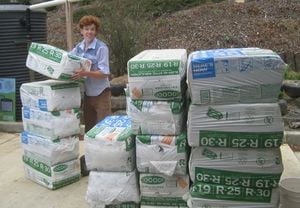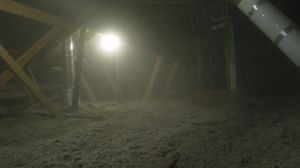Insulation made from recycled newsprint became commercially available during the 1940s when the paper industry was seeking alternative uses for leftover product.[1] The concept did not take off at first, because fiberglass insulation, which was introduced after WWII, quickly took over the market for several decades.[2] An increase in fuel prices during the 1970s led to a greater interest in creating more energy efficient buildings. Adding insulation was cheap way that new and existing buildings could be made more energy efficient by reducing heating and cooling demands.
Demand for cellulose insulation grew dramatically during this time, and many new manufacturers gained a foothold.[3] However, concerns about the fire retardant properties of cellulose, and some manufacturers' questionable claims about their product's R value, led the federal government to enact insulation standards in 1978.[2] These standards forced some manufacturers out of business due to costs associated with newly required testing. Bad publicity led to a slump in the cellulose insulation market, which left a void that was filled by the fiberglass industry.[2]
According to the Cellulose Insulation Manufacturer's Association (CIMA), cellulose currently accounts for approximately 10% of the insulation market. Due to a renewed interest in energy efficiency and environmentally friendly products, it may be fair to speculate that the demand for cellulose insulation will increase. However, cellulose insulation is still seen as an alternative to standard building practices, which often incorporate fiberglass.
This page describes cellulose insulation as a potential component of United States of America home construction.
Reasons[edit | edit source]
The Environmental Protection Agency reports that in 2008, paper and paperboard products accounted for 31% of the municipal waste stream in the United States.[4] Even though 56% (45 million tons) of all paper used by Americans that year paper was recycled, the EPA still urges the public to increase recycling efforts.[4] As long as there is paper waste being created, it makes sense to find creative, useful ways to recycle it. Cellulose insulation manufactured from recycled paper products is one way that waste can be diverted from landfills, and be used to increase building energy efficiency.
How it's made[edit | edit source]
Cellulose insulation is composed of 75-85% fiber from recycled paper (newspapers, phone books, shipping boxes, etc), and is one of the most environmentally friendly types of insulation currently available. The remaining 15-25% is composed of natural fire retardants and anti-fungal agents such as boric acid and ammonium sulfate.[5] Cellulose insulation has a very respectable R Value, ranging between 3.6-4.0 per inch. For comparison, more traditional fiberglass insulation ranges in R Value from 3.0-4.0 per inch.[6] While cellulose and fiberglass insulation are often seen as being more or less equal in their insulating properties, studies have shown that cellulose outperforms fiberglass by 36-38%. This is attributed to the fact that cellulose insulation achieves a much tighter pack in building cavities, thus allowing less air exchange.[7]
The production process of cellulose insulation starts with recycled newsprint, which is is initially ground down into small bits, around 5 cm long. Next, borates are added to aid in fire-retardation and combat mold growth. This process is followed by a high speed fiberization process that diminishes the size of the fibers to about 4mm. Lastly, the cellulose is compressed and packaged. When ready for use, the compressed material is placed in an agitating hopper, which breaks it back down into a fine material that can be blown into cavities.[8]
Boric Acid Fire Retardant
Cellulose insulation is flammable, and prone to smoldering. In order to prevent flaming or smoldering combustion, cellulose insulation is treated with 5% by weight powdered boric acid.[9] Boric acid (also known as boracic acid or orthoboric acid) occurs when the element boron combines with hydrogen and oxygen (H3BO3). There have been concerns that boric acid loses its effectiveness over time. A study conducted at Tennessee Technological University concluded that it would take 300 years for the fire retardant properties of cellulose insulation treated with boric acid to be significantly effected.[10] In other words, boric acid is an effective and stable fire retardant.
Installation Methods[edit | edit source]

While there are a few different ways of installing cellulose, it is generally installed by either the loose-fill method, or the wet-spray method.
Loose-Fill
The first method, loose-fill, involves blowing dry cellulose into small holes in preexisting walls. This technique is ideal for retrofitting old homes, or for insulating hard-to-reach areas. It also works well for insulating attics, as a wall isn't required to hold the insulation in, gravity can do that instead (though using temporary retainers can allow for a more dense application). When insulating attics with no temporary retainers, the Department of Energy suggests applying ~20% extra to offset the settling that is common with this form of application.[11]
Wet-Spray
The second method, wet-spray, is ideal for applying cellulose to newly built walls. This method differs from the loose-fill method, as the insulation now contains water, as well as a moisture retardant (generally chlorine) for combating mold-growth. Since the cellulose is now in a wet solution, it contains natural adhesive properties, making it easy to blow straight onto walls. Excess insulation is trimmed down to a proper thickness before drywall is put up.[12] Insulation that is applied wet must dry for at least 24 hours before being covered by drywall.
Drawbacks
Like any product, cellulose has a few drawbacks that should be taken into consideration. Mainly, it absorbs water quite easily (more so than most other types of insulation), and should not be installed near leaky pipes.[13] Additionally, if the cellulose is treated with ammonium sulfate in addition to or instead of boric acid, it can corrode metal that it comes into contact with either when installed wet or if it becomes wet.[2] Lastly, as stated above, loose-fill cellulose has a settling effect, so an extra ~20% should be installed if using this method.
Impacts[edit | edit source]

Hazards During Installation
Cellulose insulation produces significant quantities of dust during the installation process. The National Institute for Occupational Safety and Health (NIOSH) conducted a study based on data collected at ten different work sites to determine the occupational hazards related to installing cellulose insulation. NIOSH concluded that over exposure to cellulose insulation (according to Occupational Safety and Health Administration standards) during installation occurred at nearly all of the ten work sites. Some workers reported experiencing eye and mucous membrane irritation. Based on this study, NIOSH recommends that workers installing cellulose insulation should at least be provided with disposable, half mask particulate respirators. In enclosed spaces, such as attics, elastomeric (rubberized face seal) half mask or full-face respirators should be used.[14] In addition, wet application of cellulose insulation in attics and other enclosed spaces (where applicable) can significantly reduce exposure to cellulose dust.[14]
Long Term Indoor Air Quality
Cellulose insulation is derived primarily from recycled newspaper and boron compounds. There are a number of chemicals used in the production of newspaper, such as inks and residues from the pulp mill, that may be of concern to people with chemical sensitivities who are interested in installing cellulose insulation. However, after installation, cellulose insulation is sealed in a building's walls, and there appears to be no conclusive evidence pointing to significant impacts on long term indoor air quality.
Installation Guides and DIY Resources[edit | edit source]
Generally, installation of cellulose insulation should be done by professionals with the right equipment and experience. However, simple jobs, such as insulating an attic with loose-fill cellulose, could be done in a DIY fashion with relative ease. Below are a few resources for selecting and installing cellulose.
If you plan on installing insulation on your own, it is readily available from most large-scale hardware stores, and is certainly available from "green" construction stores.
| Greenfiber | Very informative. Walks you through how to select a proper R-value for your region, and how this applies to cellulose thickness, product type, etc. |
|---|---|
| DIY Network | Basic walkthrough of how to install loose-fill insulation in your attic. Information on how to prepare the attic, protect fixtures and vents, choosing and installing cellulose. |
| Doityourself.com | In depth guide to selecting loose-fill insulation, as well as how to prepare your home for insulating. |
References[edit | edit source]
- ↑ http://web.archive.org/web/20160226230237/http://acima.asn.au/history.html
- ↑ 2.0 2.1 2.2 2.3 Bynum, Richard T., Insulation Handbook, McGraw-Hill Professional, 2001
- ↑ Govan,Greason,McAllister. Thermal insulation, materials, and systems for energy conservation in the '80s Baltimore: ASTM International, 1983.
- ↑ 4.0 4.1 http://www.epa.gov/osw/conserve/materials/paper/basic_info.htm
- ↑ http://insulation.sustainablesources.com/
- ↑ http://web.archive.org/web/20140221175815/http://www.cellulose.org:80/HomeOwners/TableEnvironmentalFactsMaterialsTable.php
- ↑ http://www.builditsolar.com/Projects/Conservation/Insulation/Colorado.pdf
- ↑ http://www.youtube.com/watch?v=6FWOwvthj34
- ↑ Rasmussen, T.V. 2002. Creep Tests and Techniques for Predicting Densities Necessary to Prevent Settling of Loose Fill Insulation in Walls. Insulation materials, testing and applications, 4th volume, 42.
- ↑ Chiou, N. and Yarbrough, D.W. "Permanency of Boric Acid Used as a Fire Retardant in Cellulosic Insulation". Energy and Buildings, 14 (1990) 351-361
- ↑ http://web.archive.org/web/20111003092532/http://www.hgtvpro.com/hpro/bp_insulation/article/0,2617,HPRO_20150_4243847,00.html
- ↑ http://insulation.sustainablesources.com/
- ↑ http://web.archive.org/web/20120729211455/http://www.energysavers.gov/your_home/insulation_airsealing/index.cfm/mytopic=11660
- ↑ 14.0 14.1 http://www2a.cdc.gov/hhe/select.asp?PjtName=19874&bFlag=0&ID=2